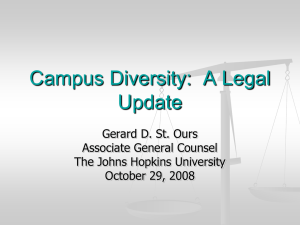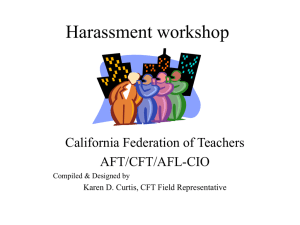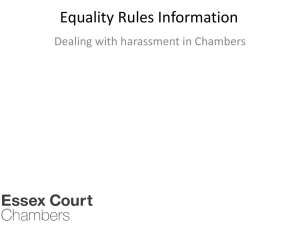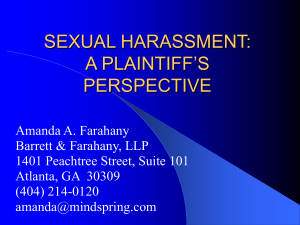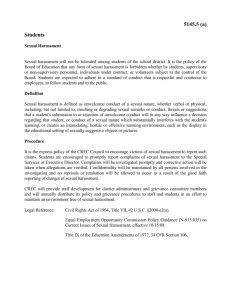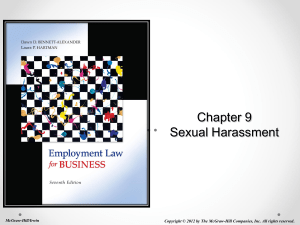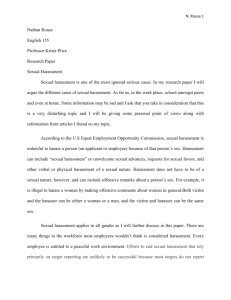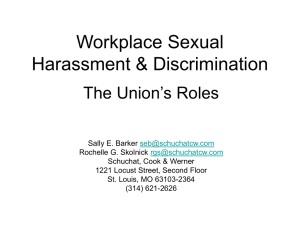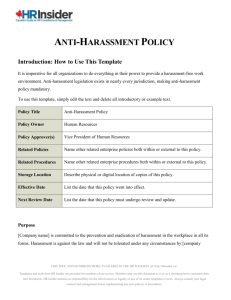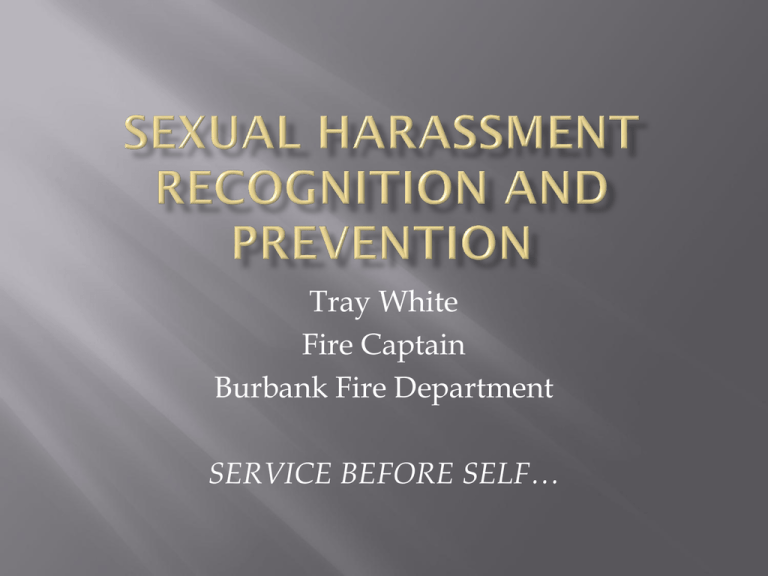
Tray White
Fire Captain
Burbank Fire Department
SERVICE BEFORE SELF…
Americans with Disabilities Act of 1990
Civil Rights Act of 1964 (amended 1972)
Government Code Section 12920
ABC’s of Federal Employment Law, 2008, Labor
Relations Information System.
Without aid of reference; recognize the
applicable laws protecting different classes of
citizens at work
Without aid of reference; understand process of
filing complaints with employer and
state/federal agencies
Without aid of reference; recognize
inappropriate behavior and know steps to
remedy the situation
It is your responsibility to know what behavior
is acceptable and what is not.
You are also expected to assist in remedying
the inappropriate behavior through direct
action or reporting.
You are protected by these statutes throughout
your employment, even during your
probationary period
Recent surveys show that 42 – 90% of all
working women report experiencing some
fashion of sexual harassment.
High costs in terms of absenteeism, decreased
work performance and health costs.
Different organization dynamic today than
there was a generation ago. We have more
women in the fire service today than before.
Title VII specifically prohibits gender based
discrimination, courts in California have ruled
that harassment is included in this definition.
The Fifth Amendment
The Thirteenth Amendment
Guarantees due process of the law
Abolishment of slavery
The Fifteenth Amendment
Guarantees the citizens’ right to voteWhy do I need
to know this?
Title VII of the Civil Rights Act of 1964
Amended in 1972
WHAT CHANGED????????
Prohibits discrimination in all phases of the
employment process because of:
Race
Color
Religion
Sex
National Origin
Disparate Treatment:
Disparate Impact:
The employer is treating ME unfairly because I am a
member of a protected class.
The employer is treating a specific group of
employees unfairly because their status as a
protected class by use of general policy.
Workplace harassment:
Conduct that unreasonable interferes with a person’s
work performance or creates an intimidating, hostile
or offensive work environment.
Defined by the court to mean:
Recruitment
Hiring
Placement
Transfers
Shift assignments
Wages and benefits
Education and training
Terminations
All other conditions of employment
Promotional procedures
Transfers
Shift assignments
Wage and benefit negotiation
Placement of personnel
Promotion
Transfers
Established to eliminate inequities found in the
employment process
Strives for everyone to be treated fairly and
equally
Goal was to have a work force that reflects, at
every level of the organization, the sexual and
ethnic composition of the surrounding area.
Is no longer used as strictly as it once was. It is
more of a guideline or desire than a set in stone
policy.
Must not discriminate against non-minorities
during its application.
A harassment compliant must be:
Sexual in nature or based on gender AND:
The conduct must be sufficiently pervasive to so
alter the conditions of employment and create an
abusive working environment.
Nature of the unwelcome sexual acts or words.
The frequency of the encounters.
The total number of days over which the sexually
harassing conduct occurred.
The context in which the sexually harassing
conduct occurred.
Whether the harasser was a supervisor or coworker.
Whether others perpetuated the harassment
Whether the harassment was directed at more than
one person.
Discussing sexual activities.
Telling off color jokes.
Unnecessary touching.
Commenting on physical attributes.
Displaying sexually suggestive pictures.
Using indecent gestures.
Using demeaning terms, such as “babe.”
Sabotaging the victim’s work.
Using crude offensive language.
Granting favors to those who participate in
consensual sexual activity.
The reasonable person test:
It applies from the male or female view of the
situation depending on the sex of the victim.
Wholly based on the victim’s perspective.
Intent of the harasser is irrelevant.
“I was just kidding.” Doesn’t excuse the harasser’s
actions.
Conduct creating a “hostile work
environment” does not have to be sexually
oriented.
Claims must be made on threatening,
demeaning, hostile or offensive conduct by a
supervisor in the workplace because of the
gender of the victim.
No sexual advances are required to claim
sexual harassment under Title VII.
What if the victim is male?
What about favoritism?
It is still harassment. This has become more
common, but less reported than female harassment.
Favors granted because of consensual sex is
considered harassment and can be claimed by those
not involved in the actual “sex.”
What about homosexual harassment?
Sexual orientation has nothing to do with whether
harassment is illegal.
Oncale vs. Sundowner Offshore Services, Inc.,
118th Supreme Court 998 (1998)
Title VII prohibits harassment against individuals of
the same sex because it is based on the victim’s
gender.
Harassing conduct need not be motivated by sexual
desire.
Physical:
Assault
Unwanted touching
Patting
Fondling
Blocking
Leaning
Exposing
Staring
Leering
Visual:
Pornographic materials
Photos depicting either men or women as sexual
objects (beefcake photos)
Unwelcome behavior:
Even if the person isn’t forced to comply with the
harasser, the behavior is still unwanted.
Person claiming harassment need not directly reject
the sexual advances or chastise the harasser.
However; they must demonstrate by their conduct that
the advances were unwelcome.
Anytime the workplace becomes uncomfortable
for an individual because of the actions or
treatment of other employees or an employee.
Hazing of new employees or employees which
have been transferred to a new assignment.
Promotion in rank and still working with or
supervising your former peers.
Treatment of individuals in groups that are not
accepted.
New person assigned to station is of different
ethnic origin, race or religion and is treated
differently because of it.
This is why you are taught these subjects…
Individuals are personally liable for their actions
and inactions.
Managers and supervisors:
Liable for not taking action to correct the situations of
harassment
Must be determined that the supervisor knew about the
harassment.
Employers:
If the supervisor harasses; regardless if the employer
knew about it they are liable.
Non-employee or non-supervisor employee harasser;
company only liable if shown they knew and didn’t act.
EDUCATION, EDUCATION and EDUCATION!
Employees need to be aware of how their action
may be perceived by others.
Would I want to be treated like that?
Would I act the same in the presence of my spouse
or mother?
Would I stand for someone treating my family in
that manner?
Would you want to read about your actions in the
front page of the local newspaper?
Rene vs. MGM Grand (pg 13)
Washington vs. Board of trustees (pg 13)
Derogatory names
Sheperd vs. Comptroller of Public Accounts
(pg 15)
Male on Male groping
Comments
Birschtien vs. New United Motor
Manufacturing (pg 16)
Retaliation
Sexual harassment and hostile work
environment is in the eye of the offended. It is
all of our responsibility to prevent it and
correct it when it occurs in our presence. This
behavior is neither professional nor necessary.
Many of the anti-hazing rules are a result of
these statutes. It is everyone’s responsibility to
know the applicable laws abide by them.
SERVICE BEFORE SELF…
Ask now or forever hold your peace…


